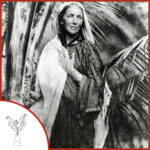

Birth: October 24, 1830
Death: August 30, 1890
Specialty: Biology and Botanical Arts
Major Contributions:
Painting incredibly accurate depictions of hundreds of plants
A number of plant species are named in her honor, including Areca northiana, Crinum northianum, Kniphofia northiana, Nepenthes northiana, and the genus name Northia.
Work on display at Kew Gardens is considered “the only permanent solo exhibition by a female artist in Britain”
As an unmarried woman in Victorian England, Marianne North rejected the roles of wife and homemaker. She also rejected the conventions that biological specimens should be painted out of context on simple white backgrounds. Her paintings instead kept the reality of the settings that she observed around the plants. Born in 1830 she was the eldest daughter of a prominent family in England and upon her mother’s death in 1855 she started traveling with her father, a member of the British Parliament until his death in 1869. As she was unmarried, she inherited her family’s wealth and decided to pursue her dream of travel and painting flora around the world.
Her first trip overseas was to North America in 1871, after that trip she spent eight months in Brazil, sometimes living in a hut in the forest, where she created over 100 paintings. North traveled to Japan in 1875 painting Mt Fuji while she was there and visiting Sarawak, Java, and Sri Lanka on her way back home two years later.
She exhibited her paintings in a London gallery but had the idea of showing them at the Kew Royal Botanical Gardens, offering to build a gallery if they agreed to display her life’s work there. While it was being built, she traveled to Australia and New Zealand and once it was complete she spent a year designing the layout of the paintings, framing, and installing her works. She had wanted coffee and tea to be served in the gallery, an idea vetoed by the director, so she settled for painting the doors and their surrounds with tea and coffee plants.
In total North visited 15 countries in just 14 years and created hundreds of oil paintings capturing the plants and animals of each area. Passing away in 1890, her work has left its mark not only on the art world, but her impact on the world of botany is also clear. As many of the plants she painted were new to Western science they were named after her, including the pitcher plant Nepenthes Northiana found in Sarawak and Kniphofia Northiae. The Marianne North Gallery at Kew Gardens houses over 800 of her paintings and is one of their most popular attractions.
Written by Angela Goad
Sources:
Planet Explorers.com: Marianne North
Marianne North Online Gallery Biography
Things you should know about Marianne North
Artist Studio Museum: Marianne North Gallery
See Also:
Royal Botanic Gardens Kew Marianne North Prints
